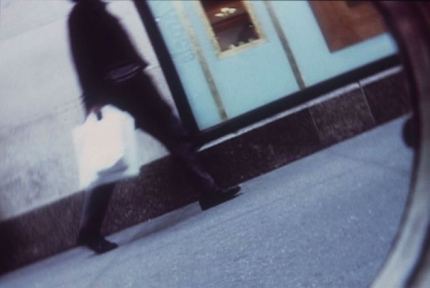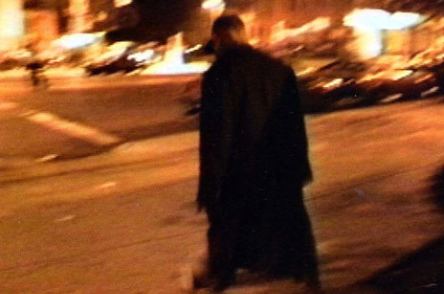From a New York Times profile of Steve McQueen:
Three years and several short films later, Mr. McQueen won the 1999 Turner Prize, Britain’s most prominent art award, in part for Drumroll (1998), a massive three-screen video that puts viewers in the midst of urban cacophony. He made it by attaching three cameras to an oil drum and rolling it down Fifth Avenue; he once called it “a musical.”
In an earlier story, McQueen elaborated:
In Drumroll, for example, the central idea was that three cameras would be rolling through New York City inside some oil drums. This was the best way for me to document a very specific urban situation. Everything was filmed. People in the street, I myself. Everything was perfect, I could do no wrong. I felt almost like a musician. All I had to do was to keep this oil drum roll almost like keeping a beat. The chaos that was recorded of people, cars, trucks, etc. was almost like improvisation. Everything that slipped into frame was permitted, it was impossible to make a ‘mistake’, everything is allowed.
It’s possible to see still images from the piece online, as in this one, from The Guardian:
 I was unable to find even a portion of the piece live. The same is true for David Hammons’ Phat Free from 1995. (Hammons is always first.)
I was unable to find even a portion of the piece live. The same is true for David Hammons’ Phat Free from 1995. (Hammons is always first.)
From Artforum, no writer given on the link. (What’s that about?)
Phat Free is only seven minutes long, but it works on the mind like a musical composition that takes days to digest. Once I’d realized that the video wasn’t about a band playing, I began searching for other clues. “Kicking the bucket” is a euphemism for dying; so I started looking for other metaphors of morbidity in the video. It was late and the streets were foggy and deserted, other than the protagonist. He looked ghostly in the blue light of the morning; perhaps he was the figure of death visiting the neighborhood.
But the video was simply too playful to support that reading.
Clearly the man was kicking the bucket the way a drummer plays a drum. The bucket rolling on the concrete established a steady rhythm, and the man – Hammons himself – repeated the same steps to reach and kick it again. I thought of the Surrealist creed that adventure is on the corner of the street – the man could be a homeless person who had found his adventure in the game and was enjoying it to no end.
By the time the video was over, I was finally getting it. Or was I? Had Hammons planted recognizable narrative motifs like “kicking the bucket,” as well as allusions to jazz and homelessness, just to keep us working endlessly in pursuit of meaning? That may be the case, since what seemed to count most was the energy of the piece. The narrative motifs were mobilized to contribute to this energy, and when the video ended, it was like putting an end to all these stories and letting the playful rhythm and movement take over as an abstract sign of the black good life.Clearly, for Hammons, there is no good life without a measure of absurdity.
After the video, Hammons told us he felt that younger black artists lacked the “black confidence” of jazz musicians. They have no control over the definition of the art they’re making. For him, black artistic confidence means a willingness to transform blackness into a higher level of abstraction. (more)
(Image via)
 I’m fortunate to have seen both pieces, the McQueen by lucky accident and the Hammons by dint of determined effort, but I’d love to be able to see them again. Sitting in my living room is ideal, but also good would be in a nearby library, museum or arts center. In the future that is almost here, we won’t be restricted by what’s on view but can make our own shows out of video/art film videos near at hand. For that service, I’d be willing to pay, and not just flash my press card to get in.
I’m fortunate to have seen both pieces, the McQueen by lucky accident and the Hammons by dint of determined effort, but I’d love to be able to see them again. Sitting in my living room is ideal, but also good would be in a nearby library, museum or arts center. In the future that is almost here, we won’t be restricted by what’s on view but can make our own shows out of video/art film videos near at hand. For that service, I’d be willing to pay, and not just flash my press card to get in.



Leave a Reply